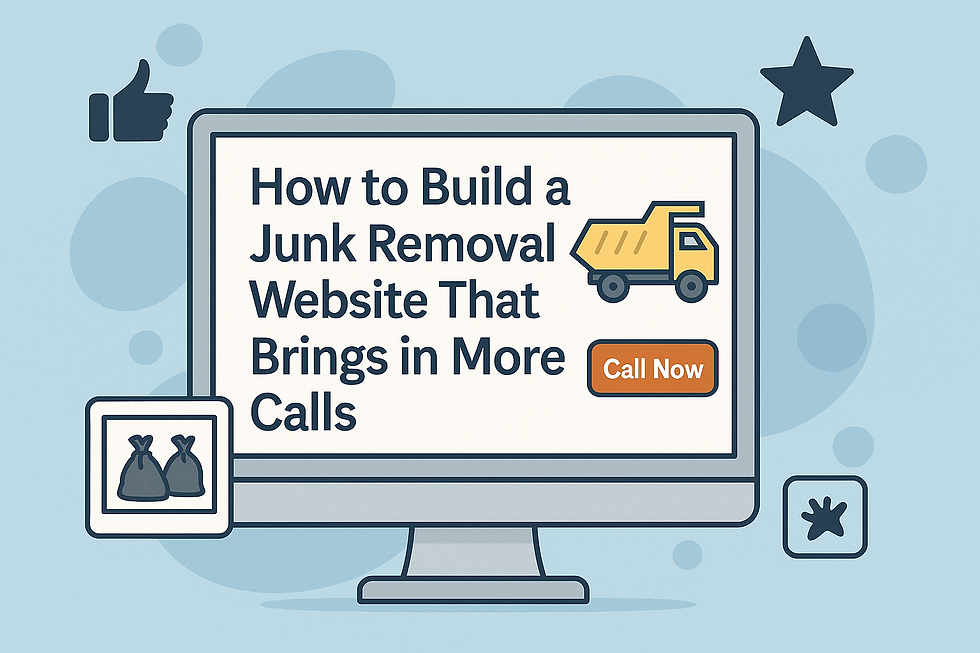How to Build a Junk Removal Website That Brings in More Calls (Even If You’re Not a Tech Person)
- Johnathon Crowder
- Aug 8
- 5 min read

Why Your Website is Probably Costing You Jobs
If you run a junk removal business, your website is often the first thing potential customers see.
Here’s the reality:
Most junk removal websites aren’t designed to sell. They’re built to “exist” — maybe a friend set it up, maybe you tried Wix or Squarespace one weekend.
The result?
Looks fine to you, but customers find it confusing.
Works on a computer, but is frustrating on a phone.
Has a few nice photos, but no clear call to action.
Has no prices, so people call the next company that does.
And in junk removal, most customers pick the first company that makes it easy to book. If your site doesn’t do that, you’re losing jobs you should be winning.
The good news? You can fix it — without becoming a “tech person.”
Step 1: Start With Your Ideal Customer
Not every junk removal job is the same — and your website should reflect the type of customer you want most.
Ask yourself:
Residential or Commercial? Homeowners need reassurance you’ll treat their property with care. Commercial clients care more about speed and reliability.
Big Jobs or Small Jobs? Do you want full property cleanouts or just single-item pickups?
Specialized Jobs? Hoarder cleanouts, construction debris, eviction cleanouts, appliance removal?
When you know this, you can:
Choose photos that show those types of jobs.
Write your service descriptions to match their needs.
Put the right “proof” on your site (before-and-after photos, reviews from similar jobs).
Example:
If you want more construction debris jobs, your homepage should show big truckloads of rubble being hauled away, mention “same-day service,” and include testimonials from contractors.
Step 2: Keep the Website Structure Simple
The simpler your site, the easier it is for people to call you.
At a minimum, your junk removal site should have these core pages:
Home – A quick, clear statement of what you do, where you work, and a big Call Now button.
Services & Pricing – List your most common services, with “starting at” prices for each.
Gallery / Before & After – Show real jobs you’ve done.
Reviews – Happy customer quotes, ideally with photos.
Contact / Book Now – Phone number, text option, and simple booking form.
That’s it. You can add extras later, but these 5 pages alone can win you more jobs than a cluttered, overbuilt site.
Step 3: Make It Mobile-First (Most of Your Customers Are on Their Phone)
When people are staring at a pile of junk they want gone, they’re probably on their phone — in the garage, the backyard, or at a construction site.
Your mobile site must:
Show your phone number at the top (tap-to-call)
Have a Call Now or Book Pickup button on every page
Load in under 3 seconds
Make it easy to see prices without scrolling forever
Have large, thumb-friendly buttons
Test this: Pull up your site on your own phone. Can you:
Find your phone number instantly?
See what you do and where you work in the first 5 seconds?
Book a pickup without hunting for the form?
If not, your customers are clicking away to someone else.
Step 4: Use Real Photos From Your Jobs
Stock photos might look clean, but they don’t convince anyone you can handle their job.
What works:
Before-and-after shots from the same angle
Action shots of your crew loading the truck
Photos with customers (if they agree) and their cleared space
Trucks branded with your company name/logo
Pro Tips:
Keep the background simple so the change is obvious.
Wear consistent shirts or uniforms in photos for a professional look.
Avoid dark, blurry, or cluttered images — they can hurt your credibility.
These photos work harder than any sales pitch. They show proof.
Step 5: Be Upfront About Pricing (Even If It’s Just “Starting At”)
One of the top reasons people don’t call is pricing uncertainty.
You don’t have to list every possible scenario, but you should give a baseline:
Example Pricing Table:
Service | Starting Price | Notes |
Single Item Pickup | $85 | Sofas, appliances, mattresses |
Half Truck Load | $250 | Equivalent to 6 cubic yards |
Full Truck Load | $400 | Equivalent to 12 cubic yards |
Why this works:
Filters out people who can’t afford you.
Builds trust (you’re transparent).
Saves you wasted time answering “How much?” calls that go nowhere.
Step 6: Make Booking Instant
Your booking process should be brain-dead simple.
Phone number in big, bold text at the top of every page
Sticky “Call Now” button that follows them as they scroll
A short booking form for people who can’t call immediately (name, number, address, job type)
Offer text messaging as an option — many people prefer it
Recommended tools: Square Appointments, Calendly, or even a simple Google Form connected to your email.
Step 7: Put Reviews Everywhere (Not Just a Reviews Page)
Reviews are powerful because they’re proof from real people.
Best placement for reviews:
Under your homepage introduction
Next to your “Book Now” button
On your services page (matched to the relevant service)
Example:
“They cleared out my entire garage in under an hour. Fair price, friendly crew, no damage to the walls.” – Jason P., Springfield MO
If you can, include a photo of the cleared space with the review — it doubles the trust factor.
Step 8: Show Exactly Where You Work
Junk removal is a local service. If people don’t see their city on your site, they may assume you don’t serve them.
You should list:
Your main city in your headline (Junk Removal in Springfield, MO and Surrounding Areas)
Nearby towns in a short bullet list on the homepage
Your full service area in the footer and on the contact page
If you serve multiple major cities, make a separate page for each — it helps with Google rankings.
Step 9: Keep Your Site Updated
A dead-looking site kills trust.
At least once a month, update:
Your gallery with a new job photo
Your reviews with a recent quote
Your offers (e.g., “Spring Cleanout Special – Book Now”)
These small updates make you look active and professional.
Step 10: Know When to Get Professional Help
You can build your site yourself, but many junk removal owners find:
It’s too time-consuming to keep updated
They can’t get it to show up in Google
It looks fine to them, but not to customers on mobile
At Crowder Code & Design, we:
Build fast, mobile-first junk removal websites
Set up local SEO so you show up when people search “junk removal near me”
Add trust-builders like reviews, pricing tables, and before/after galleries
Keep it updated so you can stay focused on hauling, not HTML
The Bottom Line
Your junk removal website is more than an online ad — it’s your salesperson that works 24/7.
A good site:
Makes it clear what you do and where you do it
Shows proof you can handle the job
Makes it easy to call or book instantly
Builds trust with reviews and photos
Do those things, and you’ll get more calls without spending a dime more on ads.
If you’d like a free custom video audit of your current site — showing exactly what’s helping and what’s costing you jobs — click here and I’ll send one right to your inbox.
No jargon, just real tips you can use.




Comments